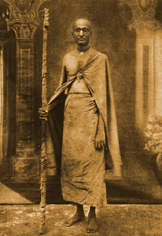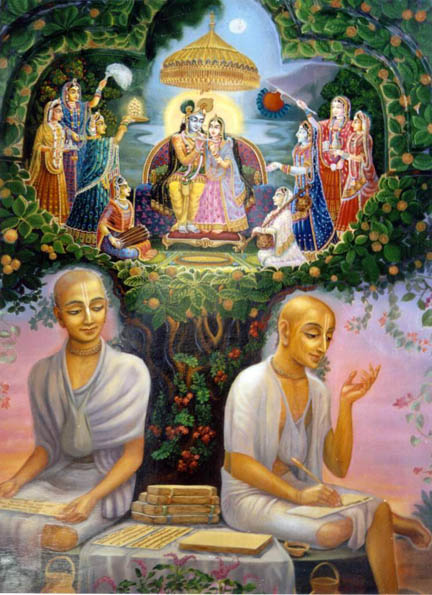
Srila Bhaktisiddhanta Saraswati Thakura Prabhupada and Raganuga Bhakti
Q&A with Swami B. V. Tripurari

Q. I understand that when one takes shelter of a bona fide guru in raganuga-bhakti that the guru eventually reveals the siddha pranali, or what I understand to be one's spiritual identity as a maidservant (manjari) of Sri Radha. What if the disciple's spiritual position is not a manjari? Is it possible that the disciple's eternal position is in Vaikuntha with Visnu instead of Goloka with Krsna?
A. Most devotees who take initiation in the Gaudiya sampradaya are destined to love Krsna in Goloka Vrndavana as either maidservants of Radha (manjaris) or cowherd friends of Krsna (gopas). This is what the sampradaya is really all about. Nityananda Prabhu's influence gave rise to a number of sakhya (gopa) lineages in Bengal, and later his consort Jahnava formed a manjari lineage, as did others. In the past there have been instances where a guru encourages his disciple to pursue one bhava only to find that as the disciple advances he is attracted to another bhava, as in the case of Duhkhi Krsna dasa who later became Syamananda. At such times the guru makes an appropriate adjustment. Similarly, if due to the broad preaching campaign of some of Mahaprabhu's followers some souls destined for Vaikuntha join his movement, they will not be hampered in attaining their ideal, and a bona fide guru will guide such disciples accordingly. Anupama, the brother of Sri Rupa and Sanatana, was an example of a Vaikuntha bhakta who was a devotee of Mahaprabhu. His ista devata was Sri Ramacandra.
The term siddha pranali does not refer to manjari bhava. It refers to a lineage of siddhas, spiritually perfected gurus, and, in particular, to their siddha status in the lila. In some Gaudiya lineages, disciples are given a spiritual form to meditate on and identify with through sadhana and are taught the spiritual identity of all the initiating gurus in their lineage. Not all Gaudiya lineages do this, nor is it necessary to have received this information to attain the Gaudiya ideal of Vraja bhakti. Along with the grace of Sri Guru, the holy name of Krsna and the Gopala mantra/Kama gayatri have the power to grant this ideal. Sri Jiva Goswami says as much in Bhakti-sandarbha when he defines diksa: divyam jnanam hy atra srimati mantre bhagavat-svarupa-jnanam, tena bhagavata sambandha-visesa-jnanam ca, "Divine knowledge (diksa) means knowledge of the true nature of God and one's own special relationship with him imparted through sacred mantra." (Bhakti-sandarbha, anuccheda 283). This approach is followed by the lineage of Srila Bhaktisiddhanta Saraswati Thakura. He emphasized this approach in opposition to misrepresentation of the name of siddha pranali, involving gurus who were neither siddhas nor sincere. One's siddha deha is not something manufactured in the mind of a conditioned soul, nor is it something to dangle before disciples of the lineage of Bhaktisiddhanta Saraswati to say, "You cannot attain Vraja bhakti without coming to our lineage."

Q. What is the teaching of Bhaktisiddhanta Saraswati on raganuga-bhakti and siddha pranali?
A. The position of Sri Bhaktisiddhanta Saraswati is that ajata ruci (without taste) raganuga sadhakas (practitioners) should adopt the methods of raganuga sadhana that they are qualified to adopt in proportion to their development of sacred greed (lobhamayi sraddha), while following the angas (limbs) of vaidhi bhakti (regulated devotion).
This follows Sri Jiva Goswami's Bhakti-sandarbha 311, ajata-tadrsa-rucina tu sad-visesa adaramatradrta raganugapi vaidhi-samvalitaivanus heya/ tatha loka-sangrahartam pratis hitena jata-tadrsa-rucina ca/ atra misratve ca tyatha-yogyam raganugayaikikrtyaiva vaidhi kartavya.
"One in whom this taste (ruci) has not arisen but who has come to appreciate raganuga-bhakti only on account of appreciation for a particular saint or scripture (sat), may still practice raganuga-bhakti but with an admixture of vaidhi-bhakti. In the same way, for the sake of preaching (loka-sangrahartaham) one who is advanced and in whom taste has manifested should also practice raganuga with an admixture of vaidhi. Such mixing of the two kinds of bhakti means that one practices vaidhi-bhakti by uniting it with whatever raganuga practices one is capable of."
In the opinion of Sri Bhaktisiddhanta Saraswati, such mixing of the two kinds of bhakti means that one embrace the angas of vaidhi-bhakti with a view to attain greater eligibility for raganuga-bhakti and its sadhya (goal) by uniting them with whatever raganuga practices one is eligible for (yatah-yogyam). In his opinion this did not include an emphasis on meditating on the pastimes of Radha-Krsna from the vantage point of one's siddha deha for those who had not attained the stage of nistha, based on the reasoning that dhyana (meditation) requires a pure heart, whereas kirtanam (chanting) does not. He reasoned, as has Sri Sanatana Goswami in Brhad-bhagavatamrta, that smaranam (remembering) arises naturally out of kirtanam. Thus he emphasized nama smaranam for beginners, stressing inoffensive chanting that would lead naturally to meditation on Krsna's form (rupa samaranam), qualities (guna smaranam), and pastimes (lila smaranam). Of course he also emphasized mantra dhyana of Gopala mantra, kama gayatri, etc., and these mantras were given to sadhakas only after they had attained a degree of steadiness in nama smaranam (japa).
In some ways his position was a reaction to what he perceived as a sleight of hand in the name of giving--or in some cases making a business out of--a type of siddha deha. In this initiation one's svarupa (spiritual identity) is thought to be revealed by the guru to the disciple for the purpose of aiding him in lila smaranam. Bhaktisiddhanta's opinion was that while sadhakas were aspiring for Vraja bhakti they should do kirtanam, and as kirtanam qualified them, they should combine it with smaranam. Furthermore, he maintained that through kirtanam one's svarupa would be glimpsed in the higher devotional stages of ruci and asakti, at which time effective and meaningful lila smaranam from the vantage point of one's svarupa could take place, thus propelling the sadhaka into bhava-bhakti. As one's svarupa arises though sadhana and the mercy of great souls, the guru helps the disciple to cultivate its realization.
The system (siddha pranali) that Bhaktisiddhanta Saraswati Thakura criticized, one traced to an eternal associate of Caitanya Mahaprabhu (Gopala-guru Goswami), is still current, but it should be made clear that Bhaktisiddhanta Saraswati Thakura criticized what he considered a distortion of this system. Today there is debate on this topic among various Gaudiya lineages as to which lineages are appropriately following this system. I have met members of the Gadadhara parivara that do not accept the system as it is applied by the current Radha Kunda lineage, and I have heard from reliable sources that members of the Syamananda parivara also differ from both of these lineages in their approach. Members of Gaudiya Matha differ from all three of these. However, I doubt that there are many devotees from any of these lineages that have taken the time to seriously investigate each other's approach, and most base their opinions on things that they have heard from third parties. While in some cases they have heard from their superiors, they often base their present position regarding the practices of other lineages upon things that superiors in their own lineages experienced decades ago.
My position as a current representative of the Gaudiya Saraswata sampradaya is that we should not criticize unless we know something is amiss by first-hand experience. Furthermore, we should judge any approach to raganuga-bhakti by the results it brings. If someone attains bhava by any particular approach, no one can argue with that.
Courtesy of Sanga Newsletter
Date: Sun, 21 Dec 2003 22:45:13 -0800
Questions or comments may be submitted at the Q&A Forum
http://www.swami.org/sanga/
or email sangaeditor@swami.org.




